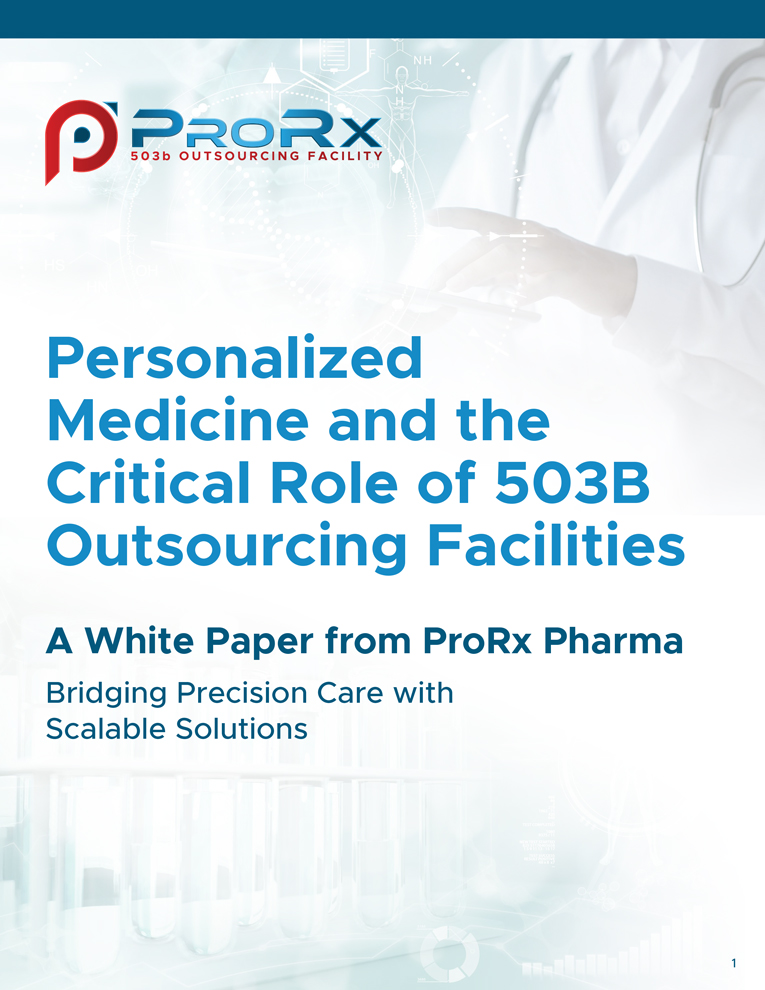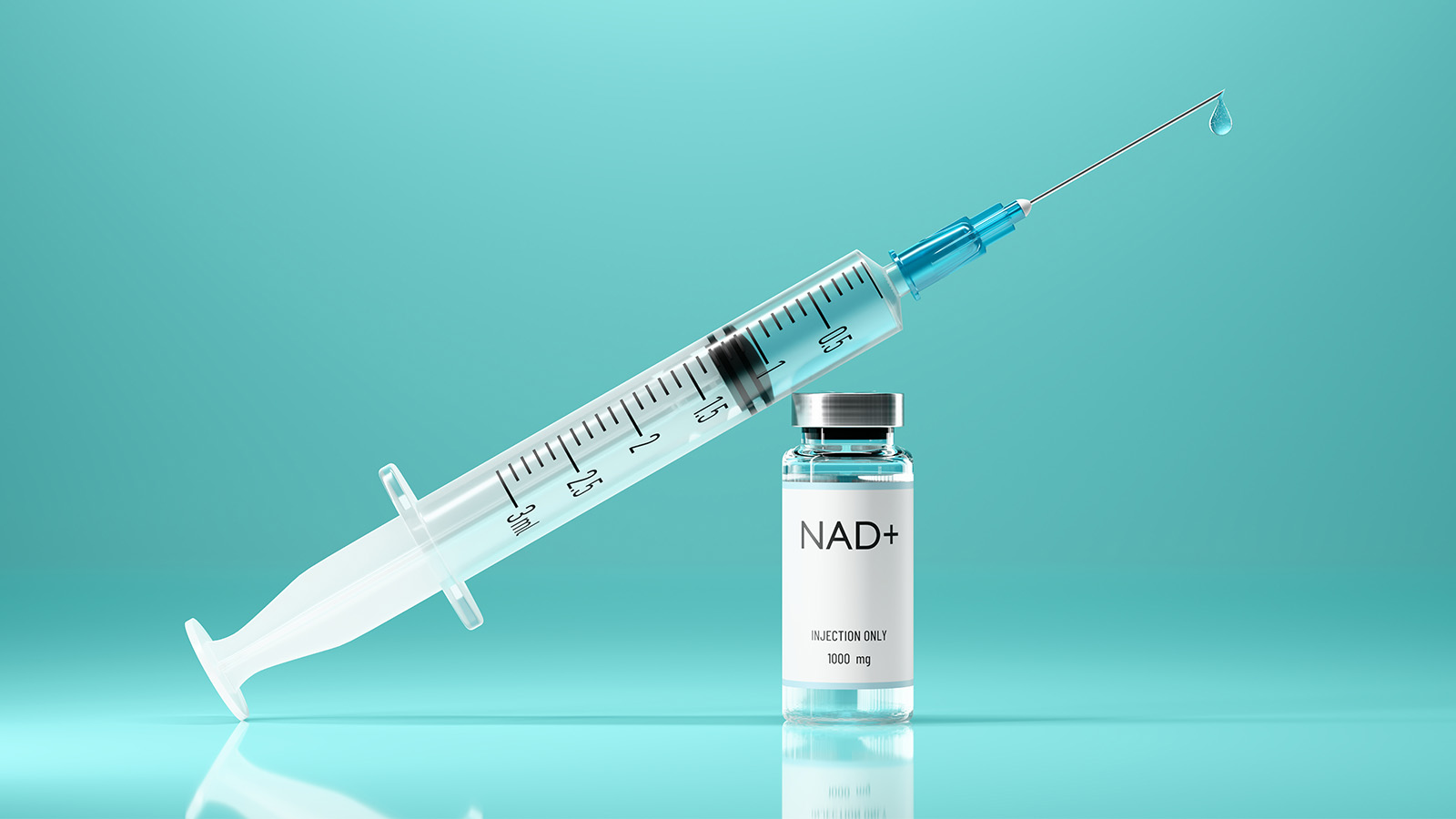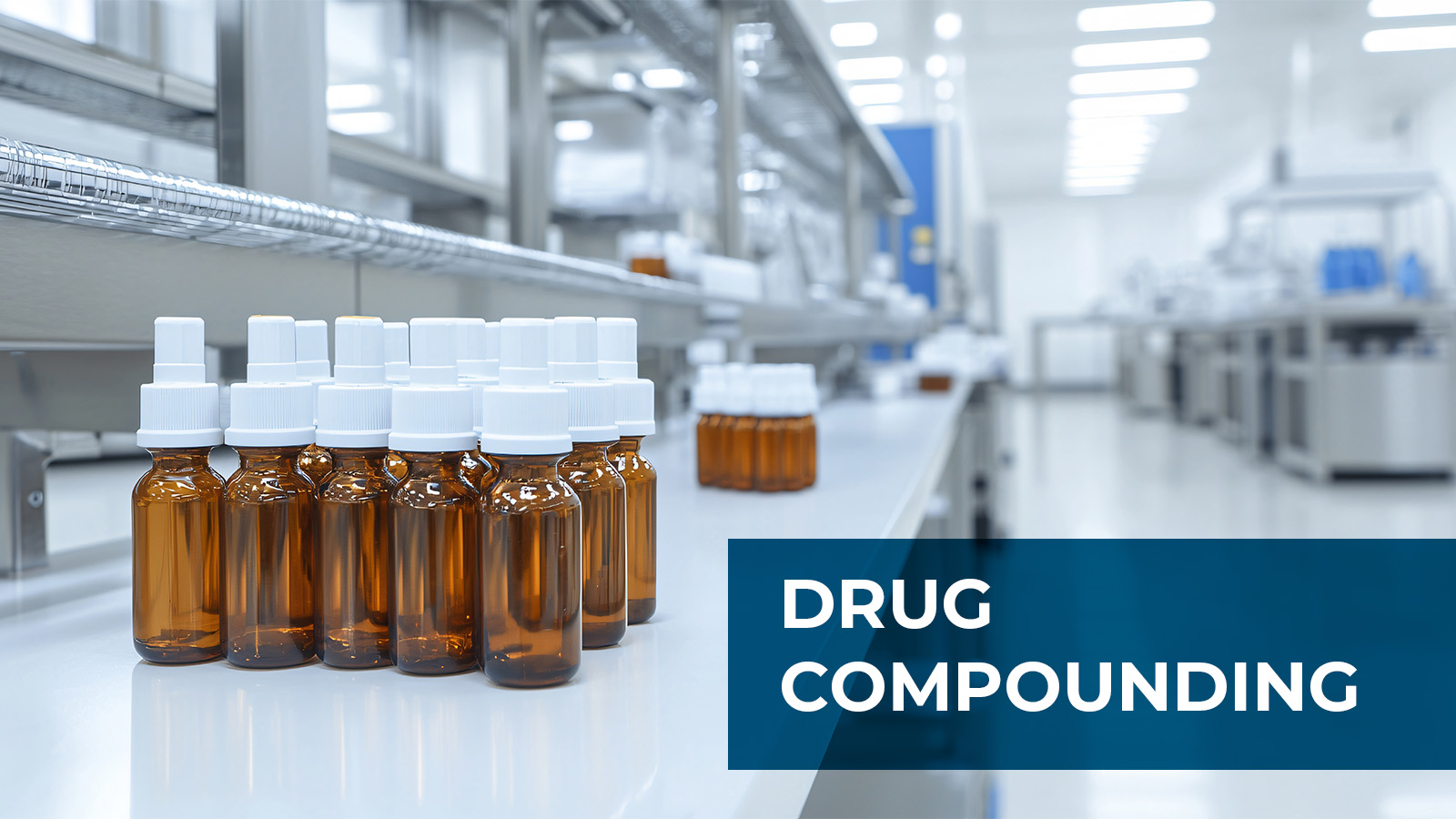A Whitepaper from ProRx Pharma
Bridging Precision Care with Scalable Solutions
EXECUTIVE SUMMARY
Personalized medicine is revolutionizing healthcare by moving beyond one-size-fits-all treatments toward tailored therapies designed around each patient’s unique biology, lifestyle, and treatment responses. This shift is driven by advances in biotechnology, diagnostics, consumer demand, and value-based care models. Compounding pharmacies—especially FDA-registered 503B outsourcing facilities—play a critical role by providing sterile, customized medications in scalable volumes, supporting clinics and providers across hormone therapy, weight management, men’s health, dermatology, and more. Despite misconceptions about 503B facilities, their stringent manufacturing standards and quality controls make them trusted partners in delivering personalized, safe, and effective treatments. As the personalized medicine market grows rapidly, understanding the role and benefits of 503B outsourcing facilities is essential for providers seeking to optimize patient care and operational efficiency.
The RISE OF PERSONALIZED MEDICINE
Personalized medicine, sometimes referred to as precision medicine, marks a transformative shift in healthcare—one that moves away from a one-size-fits-all model toward tailored treatments designed for individual patients. At its core, personalized medicine leverages a patient’s unique biological markers, health history, lifestyle factors, and treatment response data to optimize care. It prioritizes specificity over generalization, customization over convention. The goal: target the right treatments to the right patient at the right time.
This approach extends far beyond genetics or rare diseases. It’s now used across a growing number of therapeutic areas and is reshaping how conditions are prevented, diagnosed, and treated—in both clinical and wellness settings. The U.S. Personalized Medicine Market is projected to soar to $307.04 billion by 2033, up from the $169.56 billion it realized in 2024.
Where Do We See It Today?
While once considered aspirational, personalized medicine is accelerating across specialties. In oncology, molecular profiling guides targeted therapies that improve outcomes and reduce unnecessary adverse effects. In preventive care, genetic screening and diagnostics identify risk factors earlier than traditional methods. In health and lifestyle medicine, tailored protocols help patients optimize hormone levels, metabolic health, and general wellness.
A practical example: A 52-year-old woman experiencing perimenopausal symptoms might receive a compounded hormone therapy protocol aligned with her hormone panels, risk factors, and symptoms. Her plan may also integrate sleep tracking and metabolic support—customized beyond what formularies or fixed-dose combinations allow.
The Shift from Mass Treatment to Individualized Optimization
For decades, healthcare has relied on standardized treatments built for the “average” patient. But today’s consumers—and clinicians—increasingly demand a more nuanced approach. The goal is no longer just disease management, but optimization of wellness, longevity, and quality of life. This shift is evident everywhere: from hospital systems adopting pharmacogenomics to patients seeking concierge and integrative models of care that align with personal values and goals.
Care Beyond the Traditional System
One of the most visible signals of change is the rise of patients pursuing care outside traditional systems. Concierge medicine practices along with med spas, hormone clinics, and longevity centers are expanding to meet demand where conventional systems often fall short. Concierge medicine is estimated to be an $7.47 billion market this year and projected to nearly double to $13.5 billion by 2030. There are now an estimated 5,000 to 7,000 concierge doctors across the United States.
These providers use advanced diagnostics, remote monitoring, and novel therapies—many of which require precise, flexible, often compounded formulations.
What’s Driving the Growth?
The rise of personalized medicine is not a trend—it’s a structural shift, fueled by converging forces:
- Value-Based Care Models: Incentivize better outcomes and patient satisfaction.
- Consumer Demand: Patients expect care that reflects their biology, preferences, and goals.
- Biotech Advances: Innovations like Messenger Ribonucleic Acid (mRNA), Clustered Regularly Interspaced Short Palindromic Repeats (CRISPR), and peptides enable individualized treatment.
- Diagnostics & Monitoring: Wearables and genome sequencing offer real-time, precise data.
- Policy and Reimbursement: Government and payers are starting to support personalized approaches.
- Pharma Innovation: New drugs are targeting narrower patient subgroups.
- Aging Population: The U.S. population is experiencing a significant shift towards an older demographic, with projections indicating that over 73 million baby boomers will be 65 or older, comprising more than a fifth of the total population. Chronic disease in this population drives demand for customized management strategies.
- Chronic Disease Costs: Chronic conditions account for about 90 percent of the nation’s $4.5 trillion in annual health care expenditures—many requiring tailored drug formulations.
- Cultural Shifts: Wellness, longevity, and biohacking are redefining patient expectations.
Conditions at the Forefront
Personalized protocols are growing in several therapeutic areas:
- Hormone Replacement Therapy (HRT)
- Weight loss and metabolic optimization (e.g., GLP-1s)
- Testosterone Replacement Therapy (TRT), Erectile dysfunction (ED) and vitality protocols
- Dermatology (topical and injectable customization)
- Pediatrics and geriatrics (age-appropriate dosing)
- Nutritional optimization (IV therapy, vitamins, supplements)
Why Traditional Pharma Falls Short
Commercial drugmakers have made some strides, but limitations remain:
- Drug shortages and discontinuations due to low profitability.
- Rigid dosing formats that can’t meet diverse patient needs.
- Inactive ingredients that trigger sensitivities.
- Mass production that lacks customization and extended shelf life.
To bridge the gap, more healthcare providers are turning to compounding pharmacies— particularly 503B outsourcing facilities, which are FDA-registered entities able to produce customized medications in bulk for office use. These facilities follow strict cGMP standards and provide the scalable, sterile, and flexible solutions that modern care models demand.
THE ROLE OF COMPOUNDING PHARMACIES
Compounding pharmacies are increasingly critical to delivering personalized care. While mass-produced drugs are built for average patients, compounded medications are tailored to individual needs—including allergies, dose customization, and alternative delivery routes. This makes them especially valuable in HRT, dermatology, weight loss, and integrative care. The U.S. compounded medication market alone is projected to reach nearly $9.74 billion by 2033, driven by growing provider demand for flexible, patient-specific therapies not available in mass-produced formats.
Understanding the Regulatory Landscape
U.S. compounding pharmacies fall into two key categories:
- 503A Pharmacies: Traditional compounders producing patient-specific prescriptions, regulated by state pharmacy boards. Governed by United States Pharmacopeia (USP) <795> for non-sterile compounding and <797> for sterile compounding standards.
- 503B Outsourcing Facilities: Created by the 2013 Drug Quality and Security Act (DQSA) in response to public safety incidents. Registered with the FDA, these facilities can produce bulk compounded medications without individual prescriptions—but must follow Current Good Manufacturing Practices (cGMP).
Why This Matters to Providers
Providers needing ready-to-administer, sterile, or in-office medications rely on 503B facilities. These partners ensure fast access to standardized, compliant drugs without the delay of individual prescriptions—key for injectables, IVs, and hormone protocols. As demand grows for peptides and IV therapies, 503Bs offer safe, consistent solutions without requiring in-house compounding or navigating complex state-by-state laws.
503B OUTSOURCING FACILITIES IN DEPTH
503B outsourcing facilities bridge clinical need and manufacturing quality. Operating under FDA oversight, they follow cGMP standards akin to large pharmaceutical manufacturers.
These characteristics set 503Bs apart from other compounders:
- cGMP Compliance: Covers everything from production to labeling and documentation. Facilities face routine FDA inspections.
- Cleanroom Standards: Cleanroom standards are significantly more stringent and include:
- ISO 5: Workstation-level sterile compounding
- ISO 7: Buffer rooms
- ISO 8: Ante rooms
- Sterility Testing: Products are tested for potency, endotoxins, and sterility—often with third-party verification.
- Documentation: Documentation includes batch records, Standard Operating Procedures (SOPs), and certificates of analysis.
Types of Products Offered
503B facilities focus on producing sterile and non-sterile compounded medications in bulk for healthcare providers and pharmacies. Offerings can include:
- Sterile, ready-to-use IVs, vials, injectables
- Preservative-free or stability-optimized formulations
- Non-sterile office-use items like capsules and topicals
How to Vet a 503B Partner
Healthcare providers should conduct their due diligence and build relationships with reputable 503B compounding pharmacies that meet the highest standards for safety, sterility, and regulatory compliance. Likewise, 503B facilities should provide transparent pricing, timely service, and the necessary documentation to support their partners.
Three factors to consider when selecting a potential 503B partner:
- Vet for Quality Standards and Regulatory Compliance: Not all 503Bs are created equal. Ensure the facility is FDA-registered and inspected; maintains cGMP compliance; has robust testing protocols and provides access to batch-testing results; and offers transparency in inspection history and Corrective and Preventive Action (CAPA) reports.
- Ask About Documentation and Traceability Protocols: 503Bs should maintain accurate records for all their medications and be audit-ready with comprehensive traceability logs. Up-to-date records should include lot numbers, beyond-use dates (BUDs) and shipping documentation that incorporates SOPs for receiving and handling of the products.
- Inquire About Ordering Technology: To ensure more streamlined inventory management, ask about the availability of an ordering platform or portal. Leveraging the 503B’s technology will allow for faster and more cost-effective delivery of medications for patients.
WHO USES 503B OUTSOURCING FACILITIES
503B facilities support a wide range of clinical settings requiring sterile, in-office, and consistent medications. Among them:
- Hormone Clinics: Need testosterone cypionate, estradiol valerate, bi-est, tri-est, and more—ready-to-use and consistent.
- Weight Loss and Wellness Providers: Source NAD+, L-carnitine, glutathione, and other IV nutrients.
- Men’s Health Practices: Rely on hard-to-source meds like trimix, gonadorelin, enclomiphene.
- Dermatology and Aesthetics: Require sterile diluents, Vitamin C injectables, and topical anesthetics.
- Med Spas and Functional Clinics: Frequent users of injectables like MIC+B12 and Vitamin D3.
- Mobile IV and Concierge Providers: Depend on portable, sterile, and correctly labeled meds.
503B partners reduce risk, improve consistency, and streamline access to therapies that enhance patient outcomes.
COMMON MISCONEPTIONS ABOUT 503B OUTSOURCING FACILITIES
Below are the top-six common misconceptions surrounding 503B outsourcing facilities and a discussion of the facts to help healthcare providers understand their value and role in today’s increasingly patient-centric healthcare world.
- Compounded medications are unregulated and unsafe.
503B facilities are among the most heavily regulated entities in the pharmaceutical space. Unlike 503A pharmacies, which are primarily overseen by state boards of pharmacy, 503B facilities must register with, and are regularly inspected by the FDA – in addition to registering with their state. 503B facilities are required to comply with Current Good Manufacturing Practices (cGMP)—the same standards that govern large pharmaceutical manufacturers.
- If the preparations themselves are not FDA-approved, then 503B compounded preparations must not be trustworthy.
While it’s true that 503B compounded medications themselves are not FDA-approved (because they are not mass-produced, trial-tested drugs), the 503B facilities that make them are FDA-registered and FDA-inspected. This means:
- Oversight from federal authorities
- Enforcement of drug-manufacturing standards
- Mandatory adverse-event reporting
- Recall-readiness protocols
- Every batch is tested for sterility, potency, endotoxins, oftentimes by FDA registered labs
All 503B outsourcing facilities are equal.
Many potential clients think that if a facility is registered with the FDA as a 503B outsourcing facility, then it must be high quality, safe, and fully compliant—so any one is as good as the next. Being registered with the FDA is just the starting point—not a guarantee of quality. There is significant variation among 503Bs in terms of:
- Quality standards
- Capabilities
- Regulatory compliance
Hospitals, surgery centers, med spas, medical clinics, and other potential healthcare partners need to treat 503B selection like any other critical vendor decision—with due diligence, compliance checks, and performance validation.
503B outsourcing facilities can compound anything.
Another common myth is that 503B compounding is a way to get around purchasing commercial medications. This is not only incorrect—it’s also illegal. 503B facilities cannot compound drugs that are “essentially copies” of FDA-approved products unless there is a documented clinical need such as a drug shortage, a required formulation not available commercially, or an alternative route of administration for a vulnerable population. Also, 503Bs cannot use substances not approved for compounding. Clients often assume a 503B can custom-make whatever they need—that is not always true.
503B outsourcing facilities are expensive workarounds—second best or a temporary fix. They are not the ideal or standard solution. They are only a backup or alternative to use when healthcare systems, clinics, med spas, and physician’s offices can’t get what they really want.
There’s a belief that compounded medications—especially from outsourcing facilities—are inherently cost-prohibitive. In truth, 503B facilities often help healthcare providers save time and money while improving patient safety. How?
- Bulk purchasing reduces cost per dose
- Ready-to-administer formats reduce preparation errors and waste
- Sterile, pre-labeled packaging improves efficiency and reduces risk for frontline staff
- Support during drug shortages keeps essential services running without delay
503Bs are only for hospitals.
While they do serve hospitals and health systems, 503B outsourcing facilities also work with surgery centers, medical clinics, physician practices, med spas, and other healthcare providers. In addition, many 503Bs focus on specific specialties or delivery forms (e.g., ophthalmics, prefilled syringes, pain-management injectables)
CONCLUSION
The rise of personalized medicine represents a fundamental transformation in healthcare—prioritizing individualized optimization over standardized approaches. Compounding pharmacies, and particularly 503B outsourcing facilities, provide the essential bridge between traditional pharmaceutical manufacturing and the flexible, patient-specific therapies demanded today. By leveraging stringent FDA oversight, cGMP compliance, and advanced quality controls, 503B facilities empower healthcare providers to deliver safer, more effective, and scalable personalized treatments. As providers increasingly adopt personalized care models, partnering with reputable 503B outsourcing facilities will be key to meeting patient expectations, improving outcomes, and navigating the evolving regulatory landscape. Embracing these innovations ensures that personalized medicine continues to move from promise to widespread practice.










